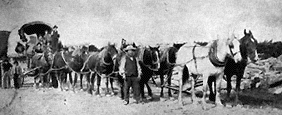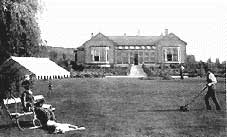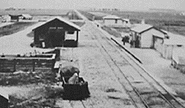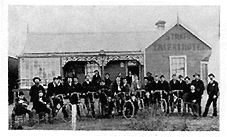|
The open plain of the Strath Taieri, with its extreme winters and hot dry summers, did not lend itself to permanent habitation in the earliest days of New Zealand's history.
There are numerous signs of human activity from those early days indicated by the number of Maori camp sites and archaeological finds some of which are on display at the local museum. Not unlike other areas in Otago, the Strath Taieri has had several different influences on its development since then. Firstly, there were the pasturalists who ventured into the swampy valley for farming in the mid 1800s.
The next development was the building of the Otago Central Railway line which began in 1879 from Wingatui near Dunedin to Middlemarch and later to Clyde. Most of the Line has now been lifted but the line from Dunedin is still operated by . The greatest effort, though, has been farming which is still the predominant industry in the area. Firstly, the valley was drained, and is now, along with the lower foothills, used mainly for sheep, cattle and deer farming, and some cropping. On the upper slopes of the Rock & Pillar range and the other ridges surrounding the valley, high country sheep farming prevails. On the Rock and Pillar, land for grazing is being reduced as some of the upper reaches revert to the Department of Conservation, while the balance of the land is freeholded by the lessees. As with most rural areas, the mechanisation of farming methods and the decline in prices for primary products has resulted in the population declining markedly from its heyday. In the 1920s many of the larger farms in the area were broken up for settlement by returned soldiers. Many were uneconomic and a process of amalgamation followed. This is continuing today as farming methods and economic trends change.
|
||
. |
||
|
The Otago Central Railway began up the Taieri Gorge from Dunedin in the 1880s and facilitated the further development of the District. The railway finally reached Middlemarch in 1891. Just four years later, in 1895, the line handled almost 2.500 passengers, 17.500 sheep and pigs, and 17.000 tons of goods. . . |
||
|
Before the railway buildings were erected, the combined townships of Middlemarch and Arden had only one hotel. That hotel was built in 1883, but subsequently burned to the ground. The present Strath Taieri Hotel was built shortly after the fire in 1921. |
||
| The Cycling Club in front of the Strath Taieri Hotel 1894 | ||
|
| Home | How to get here | Where to stay | What to do | History | Nature & Wildlife | Rural Life Skills Competition | |
||
 Taieri River could supply fish and the swampy valley moas, but the natural vegetation, mainly tussock land with few native trees, could not provide a consistent food supply. However, the inland areas of Otago were first used by the Waitaha tribe for seasonal food gathering, as well as being traversed en route to the West Coast for the treasured greenstone.
Taieri River could supply fish and the swampy valley moas, but the natural vegetation, mainly tussock land with few native trees, could not provide a consistent food supply. However, the inland areas of Otago were first used by the Waitaha tribe for seasonal food gathering, as well as being traversed en route to the West Coast for the treasured greenstone. They were closely followed by the goldminers who travelled through the area to other sites in Otago. Later they mined the areas near Middlemarch - Nenthorn, Mt Ross, the Reefs and other less significant, but no less desperate efforts, for example the failed submarine that is now at the Strath Taieri Museum.
They were closely followed by the goldminers who travelled through the area to other sites in Otago. Later they mined the areas near Middlemarch - Nenthorn, Mt Ross, the Reefs and other less significant, but no less desperate efforts, for example the failed submarine that is now at the Strath Taieri Museum. Middlemarch has its roots in the old
Middlemarch has its roots in the old 
